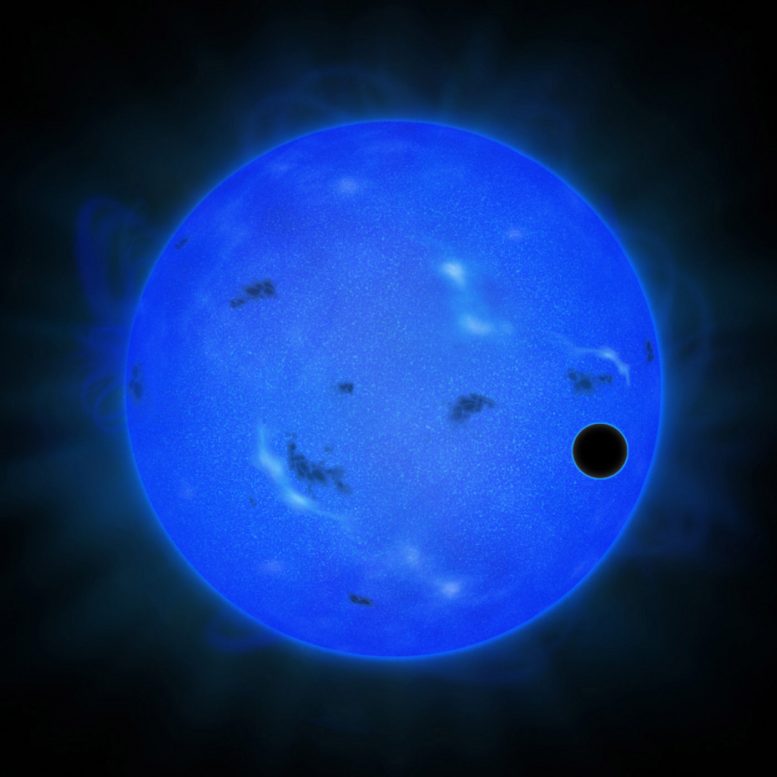
Figure 1: Artist’s rendition of a transit of GJ 1214 b in blue light. The blue sphere represents the host star GJ 1214, and the black ball in front of it on the right is GJ 1214 b. Credit: NAOJ
New Subaru Telescope observations of super-Earth GJ 1214 b show that the exoplanet is likely to have a water-rich atmosphere.
A Japanese research team of astronomers and planetary scientists has used Subaru Telescope’s two optical cameras, Suprime-Cam and the Faint Object Camera and Spectrograph (FOCAS), with a blue transmission filter to observe planetary transits of super-Earth GJ 1214 b (Gilese 1214 b) (Figure 1). The team investigated whether this planet has an atmosphere rich in water or hydrogen. The Subaru observations show that the sky of this planet does not show a strong Rayleigh scattering feature, which a cloudless hydrogen-dominated atmosphere would predict. When combined with the findings of previous observations in other colors, this new observational result implies that GJ 1214 b is likely to have a water-rich atmosphere.
Super-Earths are emerging as a new type of exoplanet (i.e., a planet orbiting a star outside of our Solar System) with a mass and radius larger than the Earth’s but less than those of ice giants in our Solar System, such as Uranus or Neptune. Whether super-Earths are more like a “large Earth” or a “small Uranus” is unknown, since scientists have yet to determine their detailed properties. The current Japanese research team of astronomers and planetary scientists focused their efforts on investigating the atmospheric features of one super-Earth, GJ 1214 b, which is located 40 light years from Earth in the constellation Ophiuchus, northwest of the center of our Milky Way galaxy. This planet is one of the well-known super-Earths discovered by Charbonneau et. al. (2009) in the MEarth Project, which focuses on finding habitable planets around nearby small stars. The current team’s research examined features of light scattering of GJ 1214 b’s transit around its star.
Current theory posits that a planet develops in a disk of dense gas surrounding a newly formed star (i.e., a protoplanetary disk). The element hydrogen is a major component of a protoplanetary disk, and water ice is abundant in an outer region beyond a so-called “snow line.” Findings about where super-Earths have formed and how they have migrated to their current orbits point to the prediction that hydrogen or water vapor is a major atmospheric component of a super-Earth. If scientists can determine the major atmospheric component of a super-Earth, they can then infer the planet’s birthplace and formation history.
Planetary transits enable scientists to investigate changes in the wavelength in the brightness of the star (i.e., transit depth), which indicate the planet’s atmospheric composition. Strong Rayleigh scattering in the optical wavelength is powerful evidence for a hydrogen-dominated atmosphere. Rayleigh scattering occurs when light particles scatter in a medium without a change in wavelength. Such scattering strongly depends on wavelength and enhances short wavelengths; it causes greater transit depth in the blue rather than in the red wavelength.
The current team used the two optical cameras Suprime-Cam and FOCAS on the Subaru Telescope fitted with a blue transmission filter to search for the Rayleigh scattering feature of GJ 1214 b’s atmosphere. This planetary system’s very faint host star in blue light poses a challenge for researchers seeking to determine whether or not the planet’s atmosphere has strong Rayleigh scattering. The large, powerful light-collecting 8.2 m mirror of the Subaru Telescope allowed the team to achieve the highest-ever sensitivity in the bluest region.
The team’s observations showed that GJ 1214 b’s atmosphere does not display strong Rayleigh scattering. This finding implies that the planet has a water-rich or a hydrogen-dominated atmosphere with extensive clouds. (Figure 2).
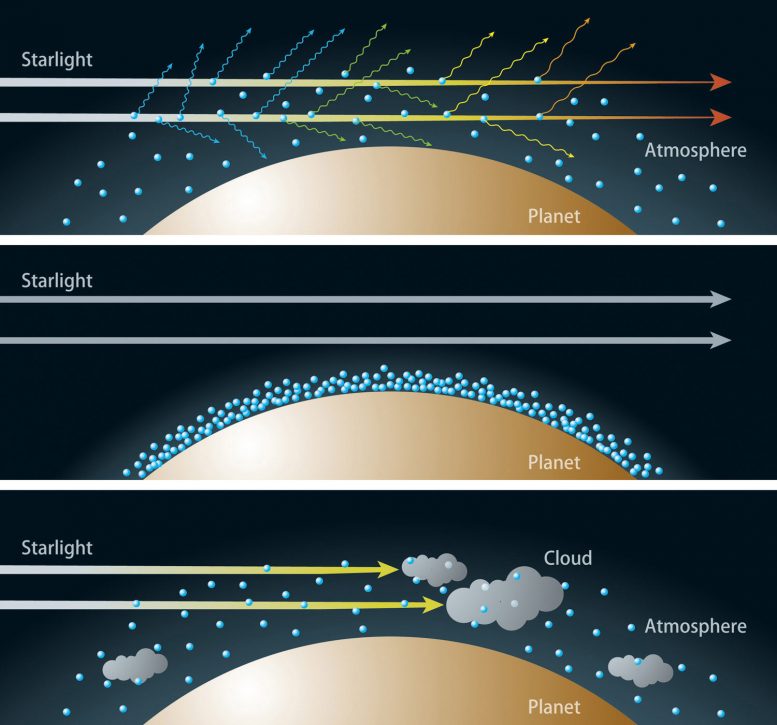
Figure 2: Artist’s rendition of the relationship between the composition of the atmosphere and transmitted colors of light.
Top: If the sky has a clear, upward-extended, hydrogen-dominated atmosphere, Rayleigh scattering disperses a large portion of the blue light from the atmosphere of the host while it scatters less of the red light. As a result, a transit in blue light becomes deeper than the one in red light.
Middle: If the sky has a less extended, water-rich atmosphere, the effect of the Rayleigh scattering is much weaker than in a hydrogen-dominated atmosphere. In this case, transits in all colors have almost the same transit depths.
Bottom: If the sky has extensive clouds, most of the light cannot be transmitted through the atmosphere, even though hydrogen dominates it. As a result, transits in all colors have almost the same transit depths. Credit: NAOJ
Although the team did not completely discount the possibility of a hydrogen-dominated atmosphere, the new observational result combined with findings from previous research in other colors suggests that GJ 1214 b is likely to have a water-rich atmosphere (Figure 3). The team plans to conduct follow-up observations in the near future to reinforce their conclusion.
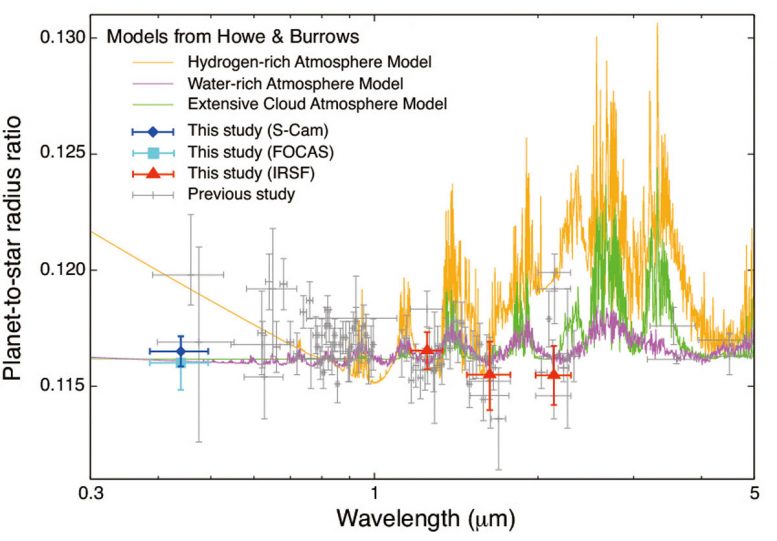
Figure 3: Observed transit depths and theoretical models for GJ 1214 b. The blue and sky-blue points are the data taken with Subaru Telescope’s Suprime-Cam and FOCAS, respectively (Narita et al. 2013). The red points are taken with the IRSF 1.4 m telescope located in South Africa (Narita et al. 2013). The three solid lines (yellow, green, and purple) represent hydrogen-rich, water-rich, and extensive cloud atmosphere models based on Howe & Burrows (2012). The Subaru Telescope data indicate no strong Rayleigh scattering in the blue wavelength. Credit: NAOJ
Although there are only a small number of super-Earths that scientists can observe in the sky now, this situation will dramatically change when the Transiting Exoplanet Survey Satellite (TESS) begins its whole sky survey of small transiting exoplanets in our solar neighborhood. When new targets become available, scientists can study the atmospheres of many super-Earths with the Subaru Telescope and next generation, large telescopes such as the Thirty Meter Telescope (TMT). Such observations will allow scientists to learn even more about the nature of various super-Earths.
References:
“Theoretical Transit Spectra for GJ 1214b and Other ‘Super-Earths'” by Alex R. Howe and Adam S. Burrows, 24 August 2012, The Astrophysical Journal.
DOI: 10.1088/0004-637X/756/2/176
arXiv:1203.1921
“Multi-Color Transit Photometry of GJ 1214b through BJHKs-Bands and a Long-Term Monitoring of the Stellar Variability of GJ 1214” by Norio Narita, Akihiko Fukui, Masahiro Ikoma, Yasunori Hori, Kenji Kurosaki, Yui Kawashima, Takahiro Nagayama, Masahiro Onitsuka, Amnart Sukom, Yasushi Nakajima, Motohide Tamura, Daisuke Kuroda, Kenshi Yanagisawa, Teruyuki Hirano, Kiyoe Kawauchi, Masayuki Kuzuhara, Hiroshi Ohnuki, Takuya Suenaga, Yasuhiro H. Takahashi, Hideyuki Izumiura, Nobuyuki Kawai and Michitoshi Yoshida, 5 August 2013, The Astrophysical Journal.
DOI: 10.1088/0004-637X/773/2/144
arXiv:1305.6985

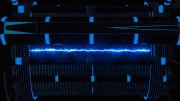
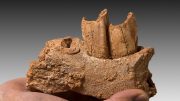
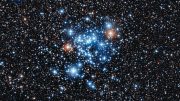

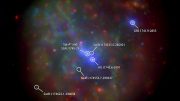
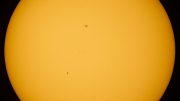

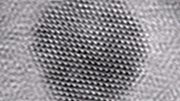
Rayleigh scattering states that light scattering is proportional to the fourth power of the frequency of the electro-magnetic radiation, and here it is the light from star. Lesser the wavelength larger would be the frequency and hence blue light and violet light would scatter off more and cannot travel deeper into the atmosphere. That is why sky appears blue and the setting sun appears red because all the blue light is scattered away in the sky by travelling more in the atmosphere at the horizon. In the constellation Ophiucus the transit of the exoplanet GJ1214b against the star which is 40 light years away, the dimming of the starlight due to transit of the exoplanet is spectroscopically studied. The light from the blue star (which is already blue) is not dimmed or scattered at all by the enveloping atmosphere of exoplanet GJ1214b,unlike our earthern atmosphere of Nitrogen and Oxygen. This denotes that its atmosphere is made up of only thin gases like Hydrogen or H2O vapour most probably. But one thing that I want to state is that even comets carry only Hydrogen and Water-ice etc and it is due to Hydrogen that it is wagging its tail when it approaches the Sun. Hydrogen rule is a general one for all the planets in the cosmos and only when this Hydrogen is combined with Nitrogen or Carbon we come across Methane (CH4) or Ammonia (NH3) atomosphere as we find on some planets of our solar system in addition to Carbon-Di-Oxide (CO2). The above method of deciding the atmosphere of the exo-planet is an ingenious method using theories of Physics by observing scattering pattern of the host star’s light only since we cannot see the exo-planet in detail and observe its atmosphere and do analysis of the spectrum from the atmosphere of the exoplanet in whatever detail we want. Thank You.